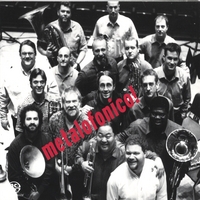
Wednesday's listening presentation was based on the theme of "Old and New." Naturally, we started by listening to the classic recording of some of the earliest music know for brass ensembles, the Gabrieli recording made by the combined brass sections of the Philadelphia Cleveland Chicago Symphony Orchestras. If you own one brass ensemble recording, this is a must. The title of this Sony CD "The Antiphonal Music of Gabrieli", and the composition we heard was Canzon septimi toni No. 2.
We then heard a different Telarc recording, made by the Empire Brass in 1985 along with some other Boston brass musicians. Despite being recorded in 1968, the digital remastered CD sounds remarkably clear. One thing we noticed between the two groups, was the the Empire Brass observed different tempo relationships at the meter changes, and had a deeper sound due to the tubas playing in the lower octaves. The Empire Brass has also released a second Gabrieli recording (re-issue?) , "The Glory of Gabrieli" with the New York Philharmonic and Boston Symphony brass sections.
We then heard both old and new music from the American Brass Quintet. Battle Suite, by Samuel Scheidt (1587-1654) is from the Delos recording "American Brass Quintet plays Renaissance, Elizabethan, and Baroque Music." Everything on that CD was composed prior to 1750.
In contrast, the works on their recording "American Premiers" featured works written between 1989 and 1993, and includes works by Shculler, Sampson, Welcher, and Jan Bach. We heard the Gunther Schuller Brass Quintet No. 2 and David Sampson's Distant Voices. Desite the chronological gap between the compositinal eras and styles of both of these recordings, it is noteable that there are some similarities, such as the use of alternating textures, dynamics through orchestration, and the exploitation of both the ability for brasses to sound loud and majestic, as well as delicate and mysterious or solemn.
[Image above from the new website for the Los Angeles Brass Ensemble. Give them a listen]



